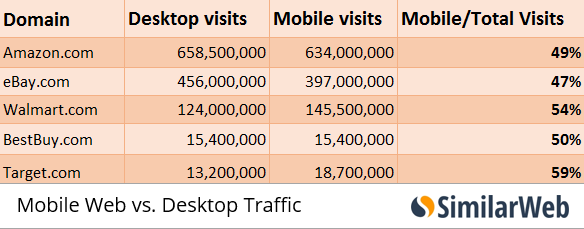Businesses around the world know that consumers now heavily depend on mobility apps. Many businesses, specifically online retailers, aren’t able to plan how they should react to the increasing drive created by smart mobile technology. On the other hand, they cannot also stay escaped from accepting mobiles as a core selling channel for a long time. A research conducted by PayPal in 2015 indicates that the growth created by m-commerce should exceed the e-commerce by three to one.
In December 2016, Business Insider forecasted that the m-commerce in the US to reach $284 or 45% of total market size by 2020. Amazon already had the double of its sales via mobile in 2013. Walmart’s 54% online visitors came from mobile devices in the last quarter of 2014. Amazon received half of all its visitors from mobile devices in the same period of time.

There are tons of similar data available that indicate the same trend. In fact, mobile has now become the key channel for retailers as suggested in a study conducted by LexisNexis.
Please note that m-commerce app-setups are generally recommended to sell only the high-profit generating products, such as clothes and accessories, health and beauty products, sport equipments, video, etc.
Doubtlessly, the m-commerce app development is rapidly growing. But this growth doesn’t mean that all e-commerce apps will succeed or deliver the desired results. In fact, many e-commerce apps are rolled back because of getting no or cold response. It happens when an e-commerce mobile application development project is created without a strong plan.
A successful m-commerce app is one which is reactive to behaviors and needs of customers. Apps created without considering the customer behavior and need will not succeed. Because smartphones are a rapid device, they have also turned people impatient. They just don’t want to wait for anything. They want every search, product information, purchase, and payment processing right in their fingertips, just in a few taps.
Delivering such experience in an m-commerce app makes its development a difficult deal. But lacking for this means the app will not survive; it would fail to deliver desired results; however, there is always hope. What ecommerce startups have to do is keep following tips in mind while developing an app.
#1. INDIVIDUALIZATION
Smartphones have made computing more personal. In fact, a member in a family would not use the phone of other members. So, smartphones are the ultimate personal gadgets. People want to use these devices in their particular ways. They customize lots of settings in their phones. The same applies on apps. When users download an app, it becomes their own. Now they want to individualize it to make them feel comfortable.
Individualization with an e-commerce app lets consumers reach their chosen brand just in a blink of eyes. They want to bookmark a product from any screen of the app, create wish-lists, and want to keep selected items stored for future purchases. They want easy payments to avoid inputting card-details for every new purchase.
An app with this level of personalization gets more consumers in comparison one that doesn’t have.
#2. SERVICEABILITY
Consumers would prefer those e-commerce apps which they can easily use. If we observe it carefully, we would see that every successful app is incredibly simple in use with easily understandable menus and mobile optimized screen layout. Different elements such as buttons, selectors, fields and next page links play a crucial role. With these features already available in an app itself, the barrier of relying on a particular make or device is just removed. The app becomes ready for almost all smartphone users.
#3. REDUCED DATA TRAFFIC
When developing an m-commerce app, focus the project on reducing the volume of data traffic. The reduced data traffic automatically reduces the load time. People like those apps which get loaded in a flash while the speed on the web connectivity may vary from network to network or location to location. Consumers will look for the same level of speed also in an m-commerce app, regardless of a business’ size or a brand’s popularity. Many e-commerce apps fail for this particular preposition.
Data traffic can be reduced by optimizing various elements in an app to consume low data along with supporting slow internet connections.
#4. SECURITY
Today, the most important aspect of an e-commerce app is the security of data being transacted between a consumer and seller. The app will require a secure data encryption and secure payment method that users take as safe to make payments for their purchase.
#5. SIMPLE ORDERING AND REGISTRATION PROCESS
Users want to buy from you, but what may distract them are overly lengthier registration and ordering processes. Customers may lose their interest in purchasing a product because of this login fatigue, even when they have fully made up their mind to buy it. When developing an e-commerce app, make sure your registration process is such simple as customers can do it just in a tap or two.
You can apply social logging in to achieve this simplicity. Tech giants like Google and Facebook have been providing account logins through their services for so long. These social services are nowadays used by almost all smartphone users.
#6. MULTIPLE PLATFORM INTEGRATION
An app with the possibility of being integrated to new attributes will grow. Design the app with keeping this particular aspect in your mind. This will happen only when you keep you interface open so that you can allow future-connections and developments for other target devices. This quality will help your app adapt to newer demands or requirements set off by new trends.
The success of an e-commerce app relied on its experience. A successful e-commerce app is one that compels users to use it for long time. Here are the ways an app can be added with compelling user experiences :
Make it simple – People love simplicity. They want simplicity even in carrying out complex operations. This is where you have to put your focus while getting your app built. Make the navigation as simple as possible. The approach should also be applied on the search, filters, and checkout functions.
Consider native approach – Go with the native development approach so that end product delivers desired results.
Increase security layers – Always prefer the trusted ones if you are using a ready-made platform. Also, you can set reminders to keep customers informed about every payment stage they are passing through.
Improve interactions consumers – Think of creatively using mobile ads, geo location services, coupons, value added features, various mobile sensors to improve interaction with customers.
Increase social interaction – You can integrate social media and encourage users to share their searches, purchases, reviews, and rating to your products through their social media accounts.
Use analytics and make changes – Keep tracking the user-behavior for your app and make changes accordingly. Analytics generates useful data that serves as the base to make a variety of changes in an app.
Partner with an experienced ecommerce app development company – Last but not least. If you really want to succeed with your e-commerce mobile app development, you better partner with a professional development firm then doing everything on your own.
Author Bio:-
Sofia is a digital marketing expert in Rapidsoft Technologies which is a leading IT consulting company providing full range it services including, IoT application development, ERP software development, and big data app development solutions.






